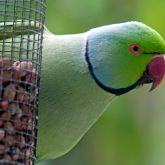Indian ringneck parrot

Indian ringneck parrot
© Pieter Van Marion Creative Commons

Indian ringneck parrot blue variety
© Patries 71 Creative Commons

Indian ringneck parrot flying
© MartijnBarends Creative Commons

Indian ringneck parrot perched
© Patries 71 Creative Commons
Native to sub-Saharan Africa and southern Asia, the Indian ringneck parrot is a popular cage bird. It is the most widely introduced parrot in the world, and wild populations have now established in Europe, the Middle East, America, and outside of the ringneck's native range in Africa and Asia.
Currently, wild populations are absent from Queensland. However, Indian ringnecks are privately kept in Queensland and, if enough of these birds escaped or were released, they could present a high risk of pest establishment.
The Indian ringneck parrot is not a prohibited or restricted invasive animal under the Biosecurity Act 2014.
Scientific name
Similar species
- Alexandrine parakeet
- Moustached parakeet
- Queen Alexandra's parakeet
Description
- Parrot with body 37–43cm long (including tail), weight 95–143g (smaller than Alexandrine parakeets).
- Feathers are usually green, but over 200 colour combinations have been bred, including yellow and blue varieties.
- Males have black and rose-coloured collar on neck, females and juveniles have no collar.
- Beak has red upper and black lower mandible.
- Tail is long.
Habitat
- Prefers tropical and subtropical lightly wooded habitats.
- Can tolerate temperate climates and habitats ranging from semi-desert to light secondary jungle.
- Generally avoids arid and mountainous areas.
Distribution
- Wild populations not yet recorded in Queensland, but captive birds are present.
Life cycle
- Usually breeds annually but can breed twice a year (breeding season varies with geographic distribution).
- Nests in tree hollows, rock faces and ruined walls.
- Lays 2–6 eggs.
- Incubation approximately 22 days.
- Young fledge at 6–7 weeks.
- Life expectancy up to 34 years in captivity.
Crops affected
- Various grains, fruit, nuts, vegetables, flowers.
Affected animals
- Native animals
Impacts
Environmental
- Can out-compete native species for resources.
Economic
- Damages various grain, fruit, nut, vegetable and flower crops.
Legal requirements
- The Indian ringneck parrot is not a prohibited or restricted invasive animal under the Biosecurity Act 2014. However, by law, everyone has a general biosecurity obligation (GBO) to take reasonable and practical steps to minimise the risks associated with invasive animals under their control.
- Local councils must have a biosecurity plan that covers invasive animals in their area. This plan may include actions to be taken on Indian ringneck parrots. Some of these actions may be required under local laws. Contact your local council for more information.
Further information
- If you see an Indian ringneck parrot and believe it may be a lost pet, contact your:
- local branch of the RSPCA
- local government animal management section
- local community animal shelter
- local pet lost and found Facebook or web page
- If you are an exotic bird owner and would like further information about your obligations for keeping exotic birds under the Nature Conservation Act 1992 and the Nature Conservation (Wildlife Management) Regulation 2006, contact the Department of Environment, Science and Innovation on 13 74 68.